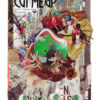Director/Producer: Craig Baldwin
Photography/Editor<: Bill Daniel
87 minutes\16mm
By their own reckoning, members of the Bay Area recording and performance group Negativland got themselves into trouble by having too much fun. Their prank began with a pirated audiotape of Casey Kasem, the normally boosterish-sounding disk jockey and radio personality, as he cursed a blue streak while trying to record a spot about the band U2. Sensing opportunity at hand, Negativland enthusiastically mixed these mutterings with samples from a U2 song, then put out a 1991 single on the SST label with a picture of the U-2 spy plane on its cover.”We didn’t know how prophetic it was that the plane was shot down,” one member of Negativland says now.”Sonic Outlaws, a fragmented, gleefully anarchic documentary by Craig Baldwin, approaches this incident from several directions. Some of the film is about the legal nightmare that ensued from Negativland’s little joke. In a highly publicized case, U2’s label, Island Records, charged Negativland with copyright and trademark infringement for appropriating the letter U and the number 2, even though U2 had in turn borrowed its name from the Central Intelligence Agency. SST then dropped Negativland, suppressed the record and demanded that the group pay legal fees. Trying to remain solvent, Negativland sent out a barrage of letters and legal documents that are now collected in “Fair Use”, an exhaustive, weirdly fascinating scrapbook about the case.Sonic Outlaws covers some of the same territory while also expanding upon the ideas behind Negativland’s guerilla recording tactics. Guerilla is indeed the word, since these and other appropriation artists see themselves as engaged in real warfare, inundated by the commercial airwaves, infuriated by the propaganda content of much of what they hear and see, these artists strike back by rearranging contexts as irreverently as possible. Their technological capabilities are awesome enough to mean no sound or image is tamper-proof today.Mr. Baldwin who expressed his own interest in culture-jamming and recontextualization through practices like altering billboards before making this documentary collage, explores the implications of this approach. These sonic outlaws specialize, according to one of them, in “capturing the corporate-controllec subjects of the one way media barrage, reorganizing them to be a comment upon themselves and spitting them back into the barrage for cultural consideration.” Those interviewed here, including members of Negativland, John Oswald and the Tape-Beatles, speak of such tactics as both cultural criticism and subversive fun. Sonic Outlaws does some recontextualization of its own by connecting such appropriation art to its antecedents: anything from Cubism or Dada to using Silly Putty to copy comic-book drawings. Using quick snippets and flashes that often emphasize the film maker’s taste for proudly tacky sci-fi movies of the 1950’s, Sonic Outlaws captures the wide range of effectiveness that such tactics can have. Sometimes the results are authentically witty and illustrate Mr. Baldwin’s ideas. But the ingenuity of toying with a Brylcreem commercial or putting words in the mouth of a video Ronald Reagan(“After all, I was the nightmare of America and the human race”) trivializes the thoughts being discussed.
What Sonic Outlaws makes intriguingly clear is that it’s a free-for-all out there on the airwaves, as piracy becomes increasingly easy and the law remains vague. Ranging from a discussion of the Fair Use concept to illicily monitoring a gay lovers’ quarrel conducted by cellular phone, the film presents a provocative range of image-tampering possibilities. And it makes clear that Negativland is hardly alone in wanting to exploit those possibilities in both reckless and esthetically daring ways. Baldwin deftly cannibalizes anything that’ll help get his point across, whether it’s a caveman pic, the Lone Ranger, Gulliver’s Travels, or Corman’s The Pit and the Pendulum. In addition, to being a sly commentary on bone-dry educational films, Craig also makes it all relevant to current day events by comparing Coronado’s bloodthirsty legacy to today’s nuclear waste industry and its similar disregard for those very same lands. But don’t get the wrong idea about this bleak look at man’s arrogance and lust for conquest–believe it or not, it’s also funny as hell! Especially during Coronado’s final, brain-damaged days, as he hallucinates his face off and stumbles about in full Conquistador regalia (with modern cities blatantly behind him). All in all, further proof that Craig Baldwin is one of the most wildly inventive indie filmmakers working today.
(taken from Other Cinema‘s website)





